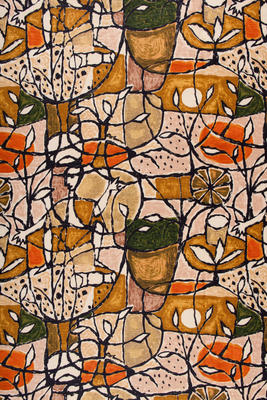Curtain
Maker & role
John Kaldor for Sekers Fabrics, Manufacturer; John Coburn (b.1925, d.2006), Designer
Production date
circa 1963
See full details
Object detail
Title
Billabong
Production place
Measurements
0 - Whole, L: 218 x W: 278cm (L: 2180 x W: 2780mm)
Production notes
The maker of the curtains is unknown.
Signature & marks
Printed on selvedge: ' “BILLABONG” BY JOHN KALDOR AUSTRALIAN ARTISTS ORIGINALS BY JOHN KALDOR SEKERS FABRIC” '
Both curtains have ‘Coburn’ (signature) printed on them at intermittent intervals.
Both curtains have ‘Coburn’ (signature) printed on them at intermittent intervals.
Credit line
Purchase, 1997
Caroline Simpson Library & Research Collection, Museums of History New South Wales
Caroline Simpson Library & Research Collection, Museums of History New South Wales
Caption
Curtain (detail), 'Billabong' design by John Coburn for John Kaldor Sekers Fabrics, Sydney, c1963
Description
In 1962, John Kaldor for Sekers Fabrics commissioned ten Australian artists to provide designs for furnishing textiles. These curtains are made from fabric from this range and were based on a painting/design by John Coburn.
The paintings and their corresponding textiles were exhibited in Sydney and Melbourne in early 1963. John Coburn's fellow exhibitors were Judy Cassab, Russel Drysdale, Cedric Flower, Donald Friend, James Gleeson, Elaine Haxton, Clem Meadmore, John Olsen and Ian Van Wieringen with designs ranging from "Terrace Houses" (Flower) to "Marine Encounter" (Olsen). An article in Woman’s Day in January 1963 declared that "art-loving homemakers, who could never afford to own original paintings by famous artists…can now turn fabric connoisseurs. They’ll be able to curtain their windows, upholster their furniture, and cover their cushions in fabrics designed by these artists."
In 2004, the CSL&RC acquired the original artwork for 'Billabong' by John Coburn (L2004/234, oil composition on board). John Coburn lived for a time as a child in Western Queensland and in the early 1960s flew over the Western Desert, influencing a series of his art works on a desert theme, which likely included the design 'Billabong'. At the time around 1962-63, Coburn's style had become looser, due at least in part to a move to a larger studio which according to Coburn gave him more space to experiment and work. 'Billabong' fits into this period of Coburn’s work – just two to three years later he was to move to his more familiar 'hard-edge' style with flat areas of colour and often completely abstracted forms.
The paintings and their corresponding textiles were exhibited in Sydney and Melbourne in early 1963. John Coburn's fellow exhibitors were Judy Cassab, Russel Drysdale, Cedric Flower, Donald Friend, James Gleeson, Elaine Haxton, Clem Meadmore, John Olsen and Ian Van Wieringen with designs ranging from "Terrace Houses" (Flower) to "Marine Encounter" (Olsen). An article in Woman’s Day in January 1963 declared that "art-loving homemakers, who could never afford to own original paintings by famous artists…can now turn fabric connoisseurs. They’ll be able to curtain their windows, upholster their furniture, and cover their cushions in fabrics designed by these artists."
In 2004, the CSL&RC acquired the original artwork for 'Billabong' by John Coburn (L2004/234, oil composition on board). John Coburn lived for a time as a child in Western Queensland and in the early 1960s flew over the Western Desert, influencing a series of his art works on a desert theme, which likely included the design 'Billabong'. At the time around 1962-63, Coburn's style had become looser, due at least in part to a move to a larger studio which according to Coburn gave him more space to experiment and work. 'Billabong' fits into this period of Coburn’s work – just two to three years later he was to move to his more familiar 'hard-edge' style with flat areas of colour and often completely abstracted forms.
Accession number
L98/53-1:2



Public comments
Be the first to comment on this object record.